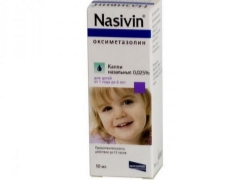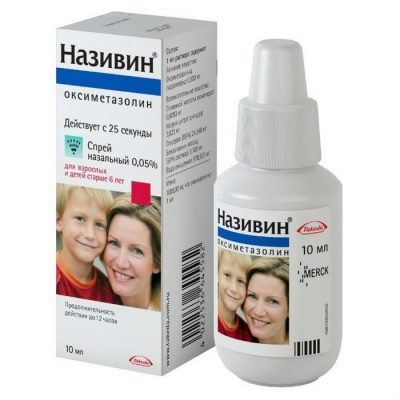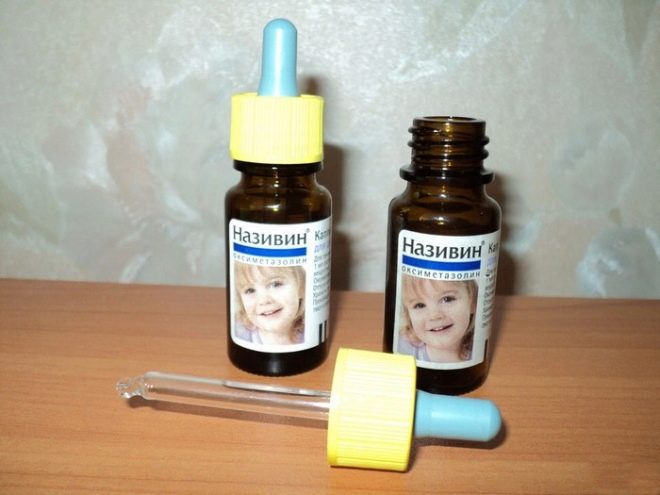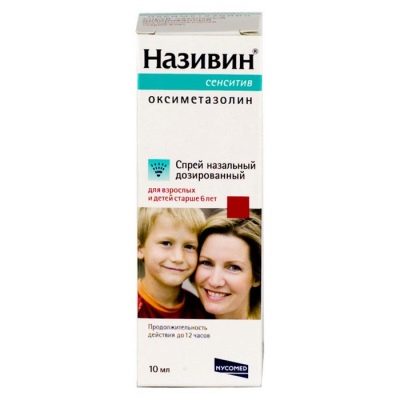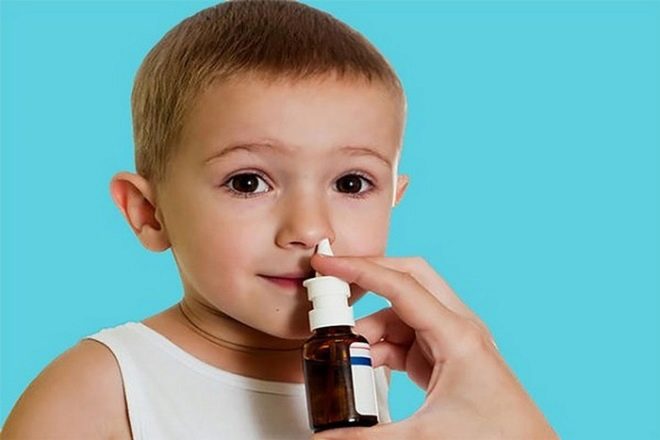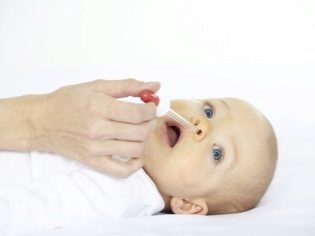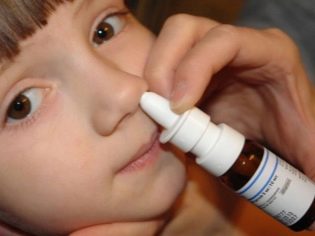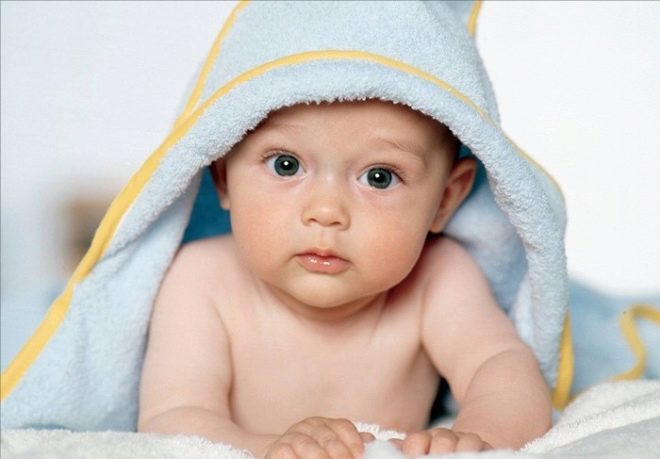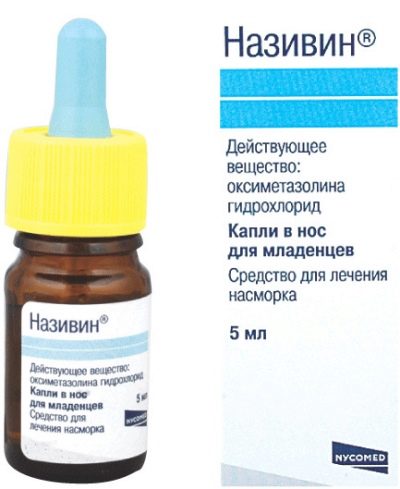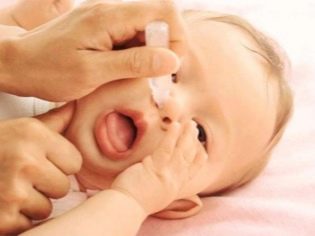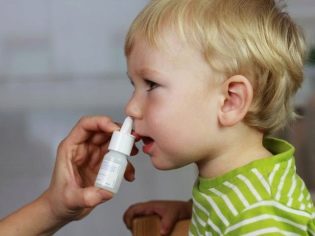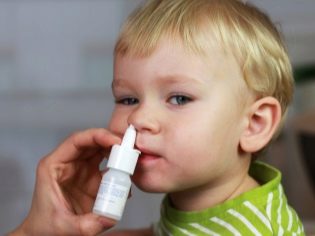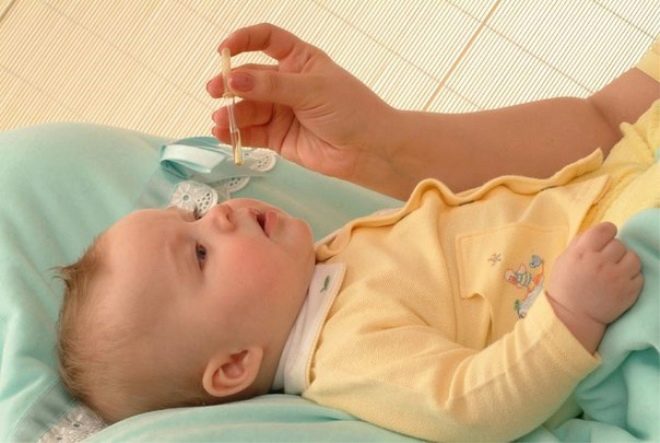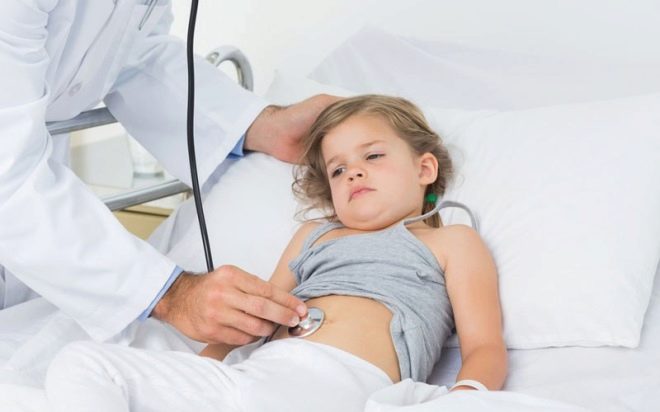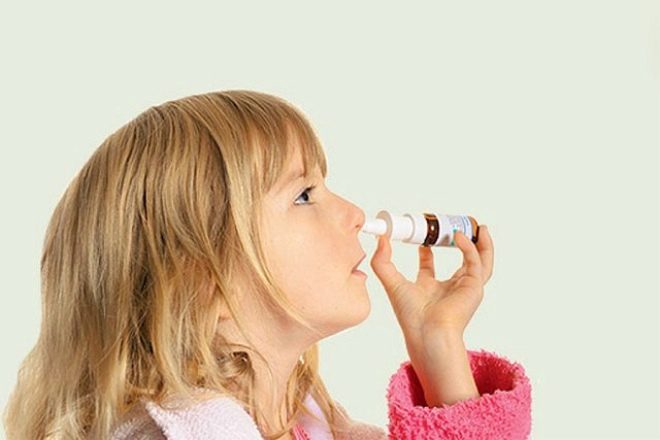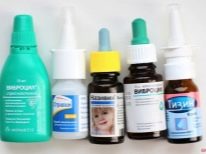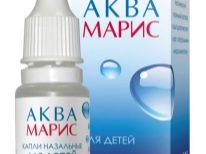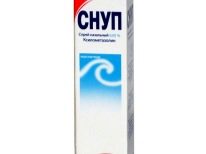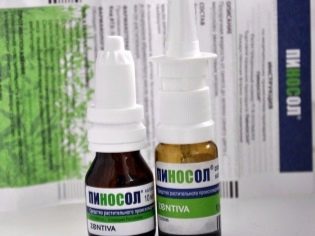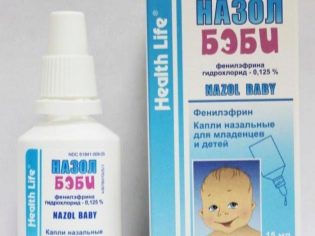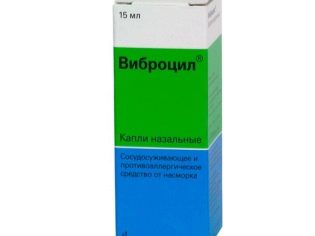Drops and spray "Nazivin Children" for children over 1 year
The causes of the common cold most often are different viruses, allergens or pathogenic bacteria. They provoke inflammation of the mucous membrane and its swelling, copious discharge from the nose, prevent breathing through the nose, eating and sleeping at night.
To combat these symptoms, children often use vasoconstrictor drugs. One of the drugs in this group is Nazivin. In what forms is it produced, how does it affect the children's body, at what dose is recommended in childhood and how to properly bury the nose with a Nazivin to a child over a year old?
Release form and composition
The drug is produced in the form of a practically clear liquid, which has no color or has a slight yellow tint. The main ingredient of this solution is oxymetazoline in the form of hydrochloride. The concentration of this substance is different, as is the packaging of the drug. Nazivin pharmacies presented:
- Nose drops. They are available in glass bottles, equipped with special pipettes on the lid. The concentration of this drug can be 0.01%, 0.025% and 0.05%. The drug with the lowest dosage is intended for children younger than a year and is represented by a 5 ml bottle. Drops with a concentration of 0.025% and 0.05% are produced in 10 ml per bottle. In addition to oxymetazoline, they contain edetate disodium, dihydrogen phosphate and sodium hydrogen phosphate, as well as water, sodium hydroxide and benzalkonium chloride.
- Nasal spray. It is produced in plastic bottles that have a spray bottle. Inside one bottle is 10 ml of solution, and the concentration of oxymetazoline in it is 0.05%, which corresponds to a dosage of 500 µg / 1 ml. Additional components of the drug are citric acid, glycerol, benzalkonium chloride, purified water and sodium citrate.
In addition, the assortment of pharmacies can be seen Nazivin Sensitive. The main component of this drug (oxymetazoline). Indications, possible negative effects and contraindications completely coincide with normal Nazivin. First of all, the drug marked "sensitive" is intended for allergy-prone children, since it does not include benzalkonium chloride and less frequently causes an allergic reaction.
One form of Nazivin Sensitive are drops, which include 0.01% of the active ingredient and are used in the treatment of infants. For children older than a year, the drug is produced in the form of a dosed spray:
- With the content of the active ingredient in a single dose of 11.25 μg, which corresponds to a concentration of 250 µg / 1 ml.
- With the content of oxymetazoline in 1 dose in the amount of 22.5 μg, that is, with a concentration of 500 µg / 1 ml.
Each of these drugs is available in 10 ml vials and contains approximately 220 doses of the drug. The bottles are made of plastic and equipped with a special metering device.
Operating principle
The active compound of Nazivin affects alpha-2 adrenoreceptors, as a result of which small vessels that are located in the nasal passages narrow. Medication use:
- Reduces swelling and hyperemia of the mucous membrane of the nasopharynx.
- Reduces nasal discharge.
- Helps restore breathing through the nose.
- It additionally affects the paranasal sinuses, as well as the middle ear, avoiding the complications of rhinitis in the form of sinusitis or otitis.
- It has a therapeutic effect only at the treatment site.
- Does not provoke redness and irritation of the mucous membranes inside the nasal passages.
The drug begins to act literally in the first minutes after it gets into the nose, and the vasoconstrictive effect after treatment with the solution lasts up to 12 hours.
Indications
In childhood, Nazivin claimed:
- In the treatment of ARVI, if the disease manifests a cold.
- In the treatment of allergic rhinitis.
- In the treatment of rhinitis, which is called vasomotor.
- In combination with other drugs for Eustachitis, adenoids, otitis or sinusitis.
- Before performing any diagnostic manipulations in the nasal passages.
What forms are used in children older than a year?
For babies, 0.01% drops are released, but older children will not have enough active compound in such Nazivin. At the age of one to six, drops are assigned in which 0.025% oxymetazoline is located. For the treatment of children older than 6 years, 0.05% solution is discharged in any form.
As for Nazivin Sensitive, in children older than one year only spray is used, one dose of which contains 11.25 μg of the active ingredient. A more concentrated product, containing 22.5 µg oxymetazoline in each dose, has been used since the age of six.
What to choose?
Choosing the most optimal form of medicine for the child, first of all, take into account the concentration of the drug, and then determined with the packaging. Note that it is very convenient to use both types of Nazivin - the drops are easily dispensed and fall directly into the nose of the kids due to the curved shape of the pipette built into the lid, and the spray is lightly sprayed sprayed over the entire mucosa at the right dose. However, in practice, the form of the spray seems most moms more suitable, because for the introduction of the drug does not need to go to bed, and the risk of overdose with this tool is minimal.
Contraindications
Treatment Nazivin prohibited:
- When hypersensitivity to oxymetazoline or another ingredient of the solution.
- With angle-closure glaucoma.
- With rhinitis, flowing in atrophic form.
If a child has any diseases of the cardiovascular system, diabetes is found, or there is thyrotoxicosis, it is necessary to drip or inject Nazivin with caution.
Side effects
Side effects include:
- Sometimes after the introduction of Nazivin into the nose, such negative local symptoms occur as dryness, sneezing, slight burning sensation, and discomfort in the nasal passages.
- After cessation of action, reactive hyperemia is often observed and the child begins to complain of nasal congestion.
- In some children, the drug provokes restless behavior, nausea, sleep disturbances, fatigue, headaches.
- Prolonged use of srey / drops is addictive and medical rhinitis. In addition, a very long treatment can cause atrophic changes in the nasal mucosa.
Instructions for use
Before injecting / dripping Nazivin, the nasal passages should be cleaned by removing excess secretions from them. To do this, it is advised to use a syringe or aspirator, because the use of cotton swabs can be dangerous, especially at an early age. A small patient is placed on a flat surface before applying the drops and the head is slightly tilted. An older child is asked to sit down and slightly tilt his head back. The medication is dripped first into one nasal passage so that the drug falls on the side wall, and then the same steps are repeated for the second nostril.
If a spray is used, the child must be warned to hold his breath. After completing the procedure, the excess solution that has leaked from the nose is wiped with a cotton pad or tissue.
Patients from 1 year to six years, the solution is prescribed in these single doses:
- One to two droplets of the 0.05% Nazivin in the form of nasal drops.
- One spray injecting Sensitive, containing 11.25 mcg oxymetazoline in each dose.
If the child is already 6 years old, then use these single dosages:
- One drop of Nazivin 0.05%, produced in nasal drops (sometimes 2 drops at a time).
- By 1 injection of 0.05% spray Nazivin.
- One injection of the drug Sensitive with the content in each dose of 22.5 μg of active compound.
The drug is alternately administered in the indicated doses, first in one and then in the second nasal passage. The frequency of use is twice a day, and if necessary, the medicine is spiked or dripped three times a day. The duration of treatment with a solution at any age is 3-5 days. If the medication did not help during this period, it is not necessary to continue the treatment. In such a situation, it is best to consult a doctor and with him to choose another therapy.
Overdose
Due to the overdose of Nazivin, vomiting, constriction of the pupils, palpitations, respiratory failure, fever, arrhythmia and other symptoms appear. If the overdose is severe, pulmonary edema, mental disorders and even coma may occur. Finding poisoning, after washing the stomach should immediately call an ambulance.
Interaction with other drugs
Like many other vasoconstrictor drugs, Nazivin cannot be used with MAO blockers or tricyclic antidepressants. Also, do not introduce into the nasal passages along with Nazivin any other means of narrowing the vessels (for example, Otrivin or Xylen), because it will increase the side effects of drops or spray.
Terms of sale
All forms Nazivina attributed to non-prescription drugs, so you can buy medicine without difficulty in most pharmacies. The price of the drug depends on its form and concentration, for example, 0.05% Nazivin spray costs an average of 140 rubles, and for 10 ml of 0.025% drops you need to pay from 130 to 150 rubles. Sensitive drugs are slightly more expensive - 160-180 rubles per bottle.
Storage conditions and shelf life
Keeping Nazivin and Nazivin Sensitive at home is recommended at a temperature of up to 25 degrees Celsius in a place where the medicine will be safely hidden from small children. The shelf life of all forms of medication is 3 years. If it has expired, dripping or injecting the solution into the child’s nose is unacceptable. The date after which the medicine is no longer used is marked on the packaging of the spray or drops and does not depend on the opening time.
Reviews
Many good reviews are found on the use of Nazivin in children older than a year, which confirm the high efficacy of the solution and praise the drug for its ease of use, the ability to choose a medicine for children of different ages and low cost. Moms say drops and spray quickly help with nasal congestion. The disadvantages of the drug include addiction to its active compound and other side effects.
Doctors also speak about Nazivin mostly well. However, they emphasize that such a tool only eliminates the symptoms of a runny nose, and does not fight the cause. For example, if rhinitis is allergic, then at the same time with the use of Nazivin it is important to identify allergens and eliminate their effect on the body of a small patient.
In addition, all pediatricians, among whom Dr. Komarovsky, warn that it is dangerous for an uncontrolled child to drip nose at a head cold and addictive. Apply any vasoconstrictor in children should be only after examination of a pediatrician, ENT doctor or other specialist.
Analogs
Replace Nazivin capable of other drugs, the action of which also provides Oxymetazoline, for example:
In addition to such means, in the treatment of rhinitis in children, drugs with other active ingredients can be used both cheaper and more expensive than Nazivin. Among them are in demand:
- Preparations made from sea water. These include Aqua Maris, Morenazal, Physiomer, Morenazal and other means produced in drops and spray. They can be used in children of any age as in the treatment of rhinitis (to flush viruses, bacteria or allergens from the mucous membrane), and for prevention (moisten the nasopharynx, avoiding drying). Inhalations with saline have a similar effect.
- Medicines containing xylometazoline. Such vasoconstrictor drugs act like Nazivin and are prescribed from 2 years of age. These include Xylen, Xymelin, Xylometazoline, Otrivin, Nosolin, Snoop, Renorus, Tizin and other means.
- Pinosol. The peculiarity of this medicine is its vegetable origin, since the main ingredients of Pinosol are eucalyptus, pine and mint oils, supplemented with thymol and alpha-tocopherol. The drug acts as an antiseptic and anti-inflammatory agent. It is produced in several forms - in the form of ointment and drops, it is used in children over 2 years old, and the spray is prescribed from the age of 3 years.
- Phenylephrine. Among these vasoconstrictor drugs to combat the common cold prescribed Nazol Baby (it is used even in children under one year old) and Nazol Kids (appointed from the age of 4). Combined agents are also in demand, as a part of which other active ingredients are added to phenylephrine, for example, Adrianol, Vibrocil or Rinopront.
- Antiseptics. They are often prescribed for rhinitis caused by bacteria or viruses. Among these drugs are usually used Miramistin, Dioxidine, Protargol or Chlorophyllipt. Before using them in children it is important to consult a doctor.
Dr. Komarovsky will tell you about the most effective medicines for the common cold in the next video.
